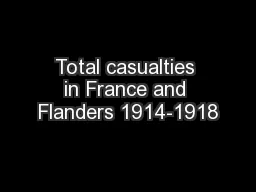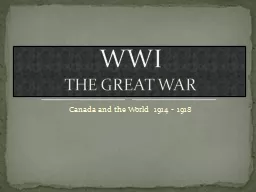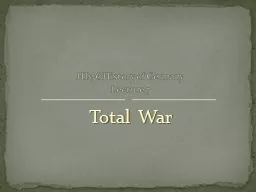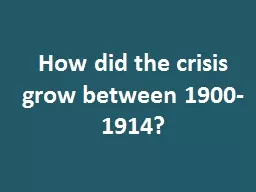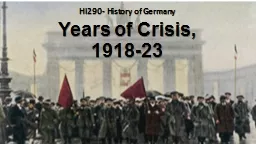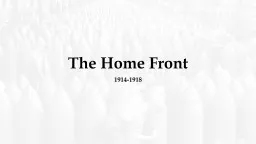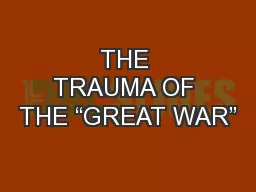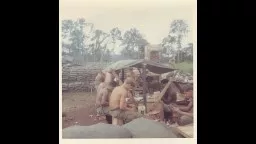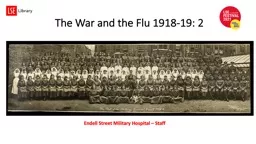PPT-Total casualties in France and Flanders 1914-1918
Author : debby-jeon | Published Date : 2017-03-20
Year Average strength of BEF in France and Flanders Killed Died of Wounds Died of disease or injury not battle related Wounded Sick or injured 1914 220572 13009
Presentation Embed Code
Download Presentation
Download Presentation The PPT/PDF document "Total casualties in France and Flanders ..." is the property of its rightful owner. Permission is granted to download and print the materials on this website for personal, non-commercial use only, and to display it on your personal computer provided you do not modify the materials and that you retain all copyright notices contained in the materials. By downloading content from our website, you accept the terms of this agreement.
Total casualties in France and Flanders 1914-1918: Transcript
Year Average strength of BEF in France and Flanders Killed Died of Wounds Died of disease or injury not battle related Wounded Sick or injured 1914 220572 13009 3657 508 55689 78049. L/0 – To identify and evaluate the reasons for the German defeat. Events in 1918 - Timeline. The situation at the end of 1917. At the end of 1917, there was . stalemate. on the Western Front. However the Allies were in deep trouble:. L/O – To identify and explain the causes and effects of the Revolution. The German Revolution. In late 1918, there was . unrest . across the whole of Germany. The emperor fled for his life and a new government took control. These events are called the . WWI . THE GREAT WAR. The Real Face of War.... M – . Militarism. : the policy of the government making the military very strong. . A – . Alliances system. : where countries make agreements that if they are attacked the friendly country will help them.. HI136 History of Germany. Lecture 5. The July Crisis. 28 June:. Archduke Franz Ferdinand assassinated at Sarajevo.. 5 July:. Kaiser Wilhelm II offers Germany’s unconditional support (the ‘blank cheque’) to Austria-Hungary.. By John McCrae. Objectives. Analyze “In Flanders Field” using the TPCASTT process. Identify the structure of the poem, evaluating how pleasant imagery is used as a framing technique. Investigate the impact of rhyme scheme on the tone of the poem. American Playwright, 1888-1953. Eugene Gladstone O'Neill. (October 16, 1888 – November 27, 1953) was an American playwright and . Nobel laureate. in . Literature. . His poetically titled plays were among the first to introduce into American drama techniques of . How did the crisis grow between 1900-1914?. Lesson aim:. To have evidence of . six key events . that caused a growing crisis by 1914. . TASK:. . Just check thorough your book. Make sure things are neat, titles underlined etc. . HI290- History of Germany. The Birth of German Democracy?. Did 1918 mark a break from the 19. th. century?. How revolutionary were the events of 1918?. What compromises led to birth of the parliamentary republic?. . By John McCrae, May 1915. In Flanders fields the poppies blow. Between the crosses, row on row,. That mark our place; and in the sky. The larks, still bravely singing, fly. Scarce heard amid the guns below. L/O – To identify and explain the causes and effects of the Revolution. The German Revolution. In late 1918, there was . unrest . across the whole of Germany. The emperor fled for his life and a new government took control. These events are called the . Want this PowerPoint?. www.michaelmolkentin.com. In explaining the outcome of the Great War how important was the home front relative to the battle front?. 0 1 2 3 4 5 6 7 8 9 10. What?. Total war is the commitment of a nation’s entire human and material resources to the attainment of victory in an armed conflict. . Many historians today regard Imperial Germany as the aggressor in 1914, but almost all Germans BELIEVED at first that they were fighting a legitimate war of national defense against Russian aggression. . . Total numbers of casualties from Vietnam War by state. Total numbers of casualties from wars in Afghanistan and Iraq by state, 2014. UVA Center for Politics. Endell. Street Military Hospital – Staff . The end of the war at . Endell. Street Hospital. Operations and treatment of patients were going on as normal when the war ended. . When the news spread, some of the staff rushed out to buy cakes and chocolate for the soldiers and doctors and nurses..
Download Document
Here is the link to download the presentation.
"Total casualties in France and Flanders 1914-1918"The content belongs to its owner. You may download and print it for personal use, without modification, and keep all copyright notices. By downloading, you agree to these terms.
Related Documents

